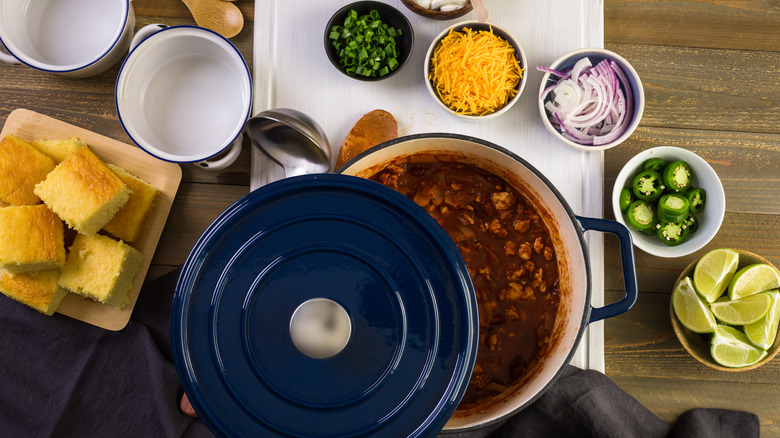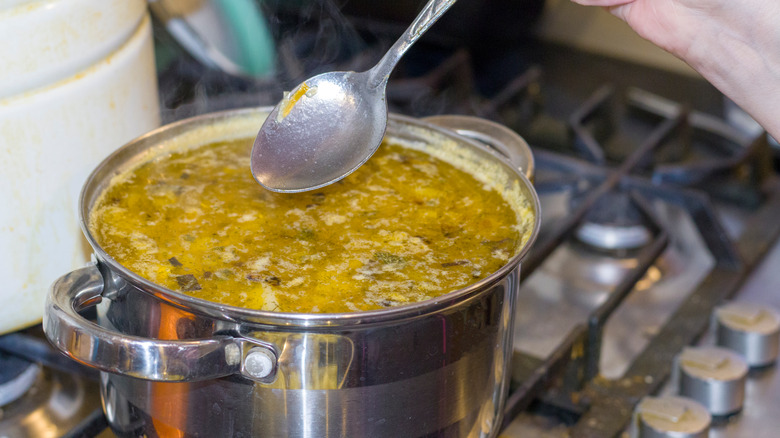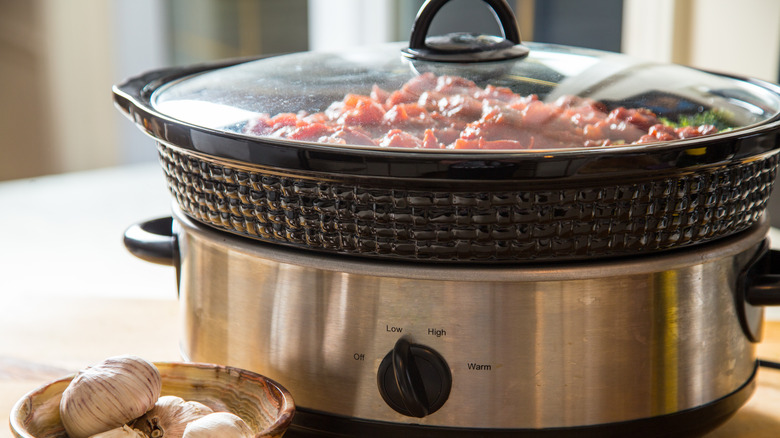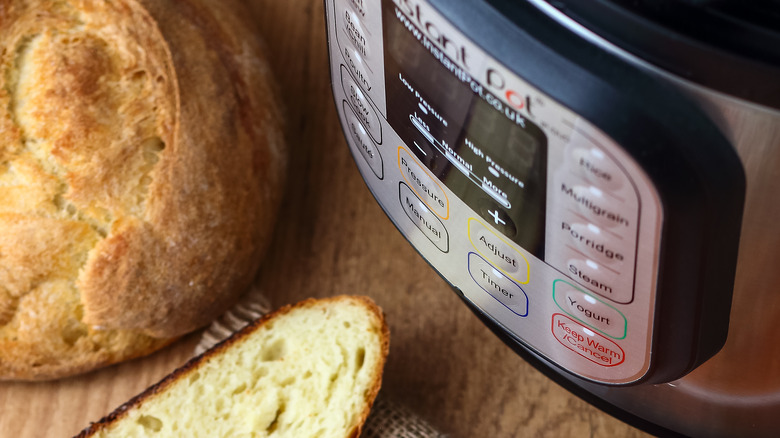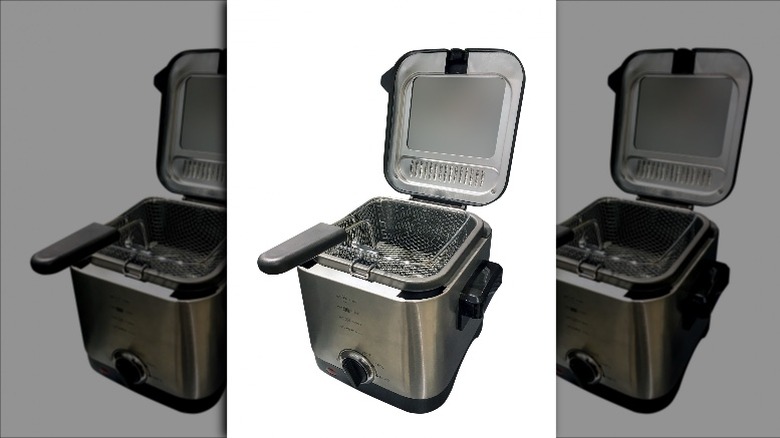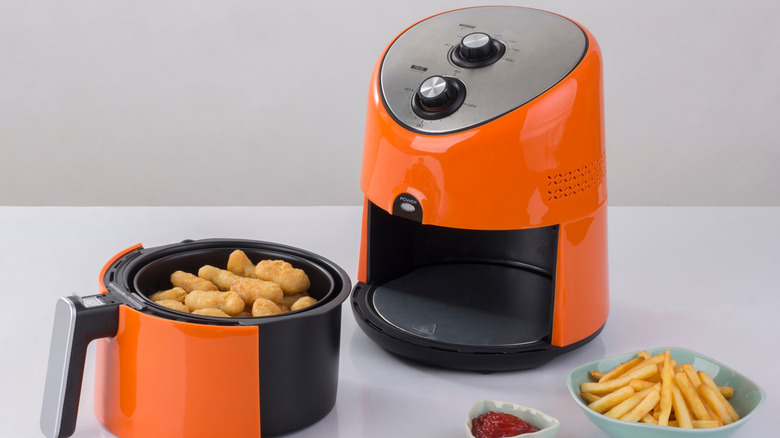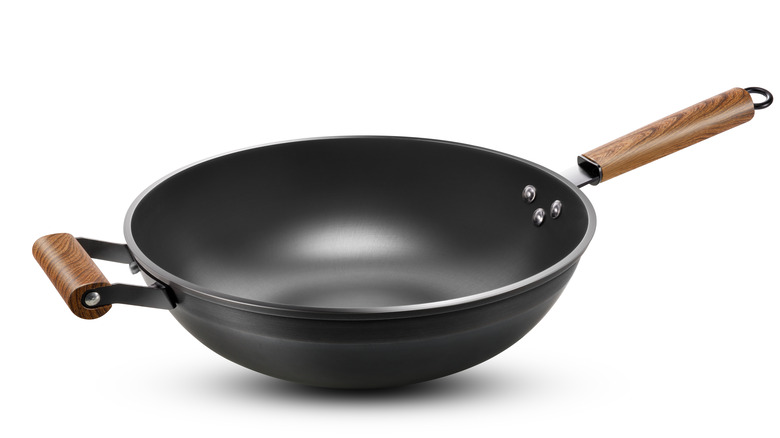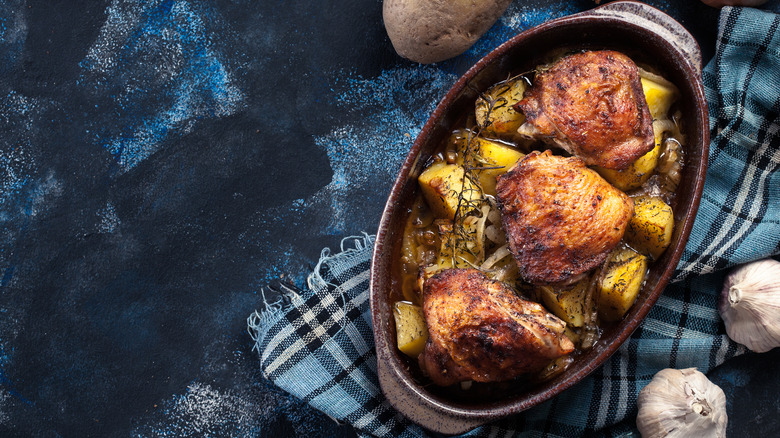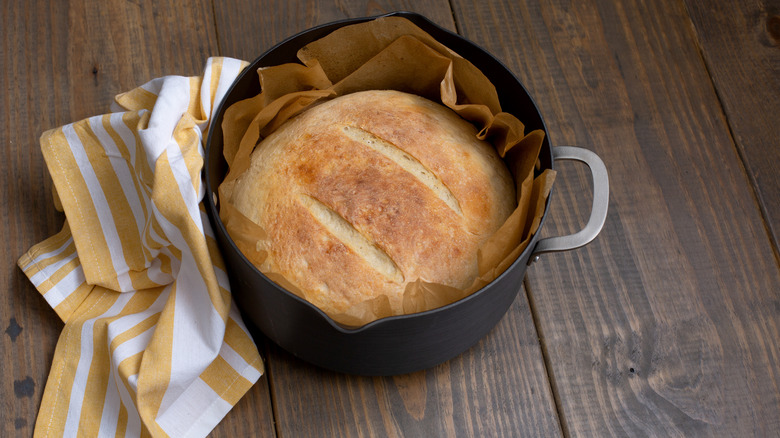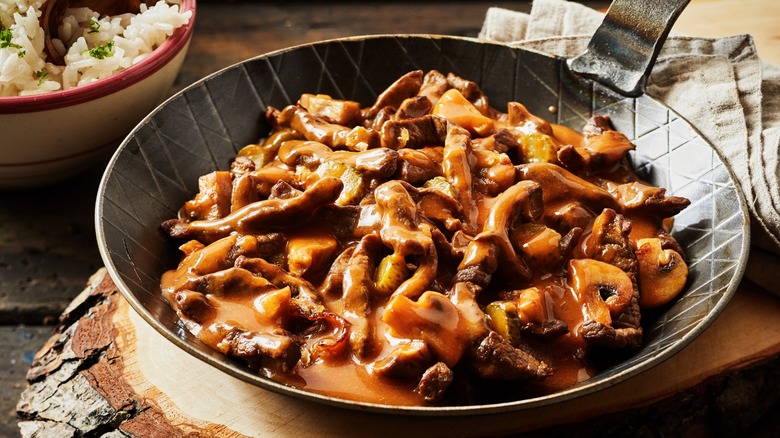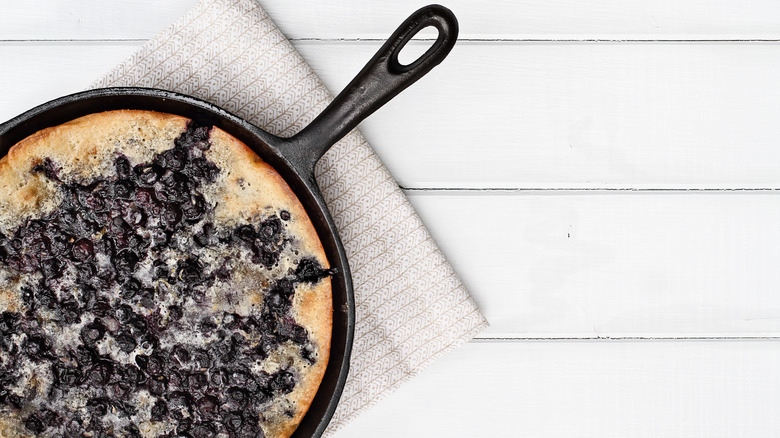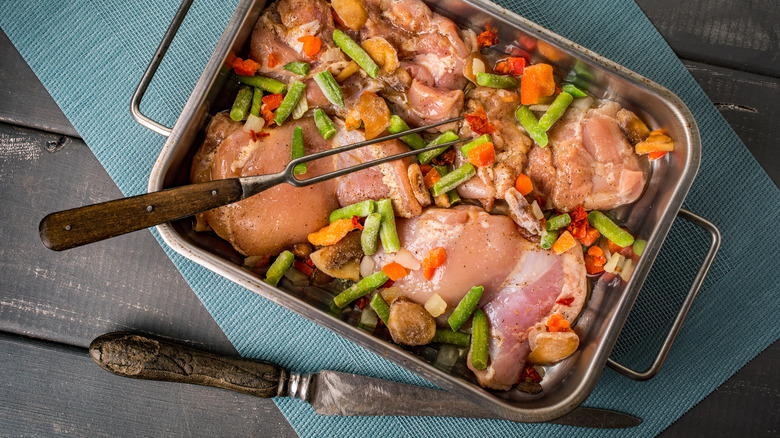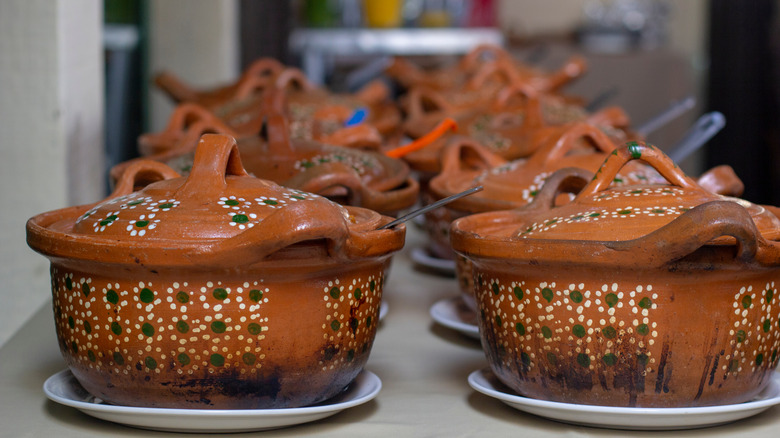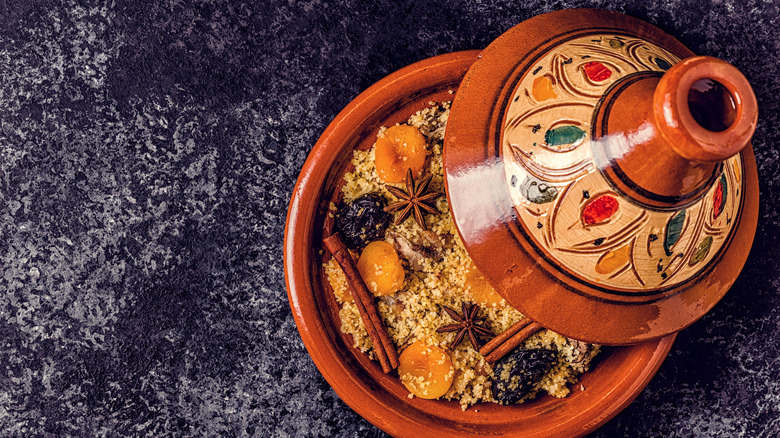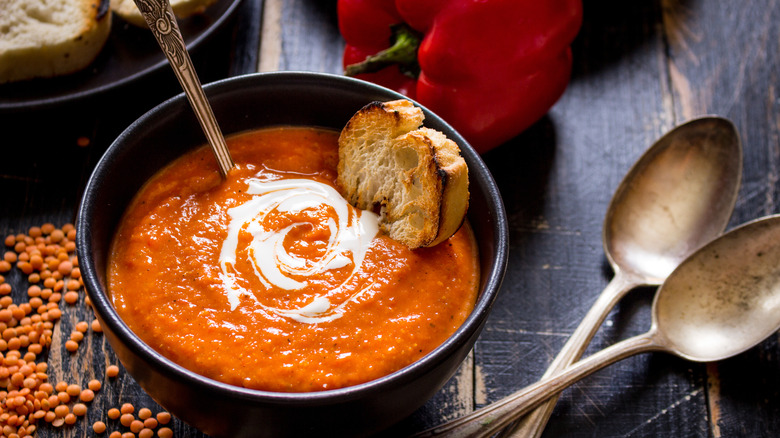The Best Substitute For A Dutch Oven
A Dutch oven is one of those cooking tools every kitchen should have. It can do almost anything because it's both oven- and stovetop-safe, so you can start dishes on a burner and finish cooking them in the oven. These heavy pots are usually made from enameled cast iron or ceramic, so you can use them at high temperatures. Not only that, but they hold heat well, maintaining the perfect simmer for an all-day braise or working to keep your food warm long after it leaves the oven. You can use them for almost everything; braised meats, soups and sauces, casseroles, fried food, and even baking bread or cookies.
The only problem with this type of cookware is it's expensive. You can find budget picks at places like Costco or IKEA, but The Kitchn points out these inexpensive brands are usually made in China without the strict oversight that monitors the quality of the bigger brands. Le Creuset and Staub cookware can easily cost over $300, and the price tag goes up when you look at the larger pots. If you don't have the budget to pick one up and you want to make a recipe that calls for one tonight, you don't have to run out to the store. Use something else in place of a Dutch oven. The culinary minds at Mashed know an alternative to the Dutch oven for almost every method of cooking.
A soup pot or stockpot is a great Dutch oven substitution
The most common substitution for a Dutch oven is a stockpot. Most cookware sets come with an 8-quart stockpot, so you probably have one on hand. These pots have tall sides that make them perfect for large tasks like boiling pasta or simmering bone broth, so they can likely handle whatever you planned to cook in a Dutch oven. You might not even need to reach for the largest pot, either. If you're making a small amount of tomato sauce for pasta, or cooking rice for two, you can get away with using a 2- or 3-quart soup pot.
You can also use a soup pot or stockpot for simmering soups and stews, creating homemade sauces, or making applesauce. Depending on the pot's material, you may (or may not) be able to use it in the oven, but you might not need to. Most braised meat dishes that call for transferring the pot to the oven can also be finished on the stovetop over a very low heat setting.
Use a slow cooker or a Crock-Pot instead of a Dutch oven
Slow cookers like Crock-Pot are one of the more popular cooking appliances in America. A 2019 Consumer Reports article reported that an estimated 8.7 million units were sold in a recent 12-month period. That's a lot of slow cookers! These set-it-and-forget-it appliances can do almost everything you can do in a Dutch oven, all without having to fiddle around with oven temperature. According to the Williams Sonoma slow cooker to Dutch oven conversion guide, you can use the same cook time used in your Dutch oven recipe if you use the slow cooker's high cook setting. Or, for a more gentle cooking experience, use the low setting and double the cook time.
Look to your slow cooker to make braised dishes like lamb shanks, pulled pork, one-pot pasta dishes, soups, or stews. And, just like a Dutch oven, a slow cooker can keep your food warm for hours after it's finished cooking. One thing you can't usually do in a slow cooker is sear meats. If your Dutch oven recipe calls for browning the meat before simmering it in sauce, you'll have to use a separate pan like a cast-iron skillet.
Convert your Dutch oven recipe to use the Instant Pot
The Instant Pot is newer to the scene than the slow cooker, but it has become wildly popular. what makes this seven-in-one appliance so appealing is its ability to make most recipes (like the ones you would normally prepare in your Dutch oven) easier or in a fraction of the time. Take risotto, for example. In a Dutch oven, you would have to spend 20 minutes continuously stirring the rice and warm stock, adding the latter one ladle at a time from a second pan. However Instant Pot risotto is a hands-off, one-pot dish. Simply add the ingredients to the pot, set the timer, and come back to a creamy, comforting bowl full of food.
Other dishes (like braised meats and stews) take a fraction of the time to cook in the Instant Pot. It cooks food around 30 percent faster because the steam trapped inside the electric pressure cooker can heat to hotter temperatures than regular pots and pans. To convert your Dutch oven recipe for the Instant Pot, lower the cooking time by a third. You also won't need to use as much liquid because there is no evaporation in an Instant Pot, although it does require at least 1-1/2 cups to generate steam. It's also best to add any dairy at the end of the cooking time, as it can curdle in the Instant Pot's high heat environment.
You don't need a Dutch oven to fry food when you have an electric tabletop Fryer
There are definitely some benefits to frying in a Dutch oven. Andrew Zimmern likes how Dutch ovens are heavy enough to maintain the heat of the frying oil. They also feature tall, deep sides that can help prevent hot oil from splattering around your kitchen. As compared to an electric fryer, you also don't have to worry about putting it on the counter close to an outlet. That said, if you like deep-frying and want to do it often, we wouldn't suggest buying a Dutch oven just to fry food. You may want to consider an electric tabletop fryer instead.
Sure, the fryer is only good for one thing while the Dutch oven is significantly more versatile, but a tabletop fryer is available for a fraction of the cost. A quick search on Amazon reveals several models under $100. There are other pros for using an electric fryer: the temperature is much easier to control than a stovetop fryer, and most models come with odor filters to reduce that characteristic fried food smell.
Skip the calories and fat by using an air fryer instead of a Dutch oven
Speaking of frying food, you might be able to skip the oil frying all together with an air fryer. When you use a Dutch oven to fry food, you're doing something known as "deep-frying." This involves heating fat to high temperatures (usually 350 to 375 degrees Fahrenheit) to dehydrate the outside of the food, forming a crust that prevents the oil from penetrating into the food's interior. That means the outside will brown and crisp up while the inside stays tender and moist.
An air fryer is basically a tabletop convection oven: It has a heating element and a fan that rapidly blows hot air around the food. Because the hot air moves around faster than inside most ovens, the outside of the food crisps up — just like when you fry food in a Dutch oven. As an added bonus, this method doesn't require any fat to function, so air-fried food typically has fewer calories and less fat than food cooked in a deep fryer.
You can also fry food in a wok instead of a Dutch oven
OK, we promise we won't belabor on fried food too much longer. It turns out a Dutch oven, an electric tabletop fryer, and an air fryer are not the only ways to make fried food. Did you know you can deep-fry in a wok? It's true! If you happen to have a wok on hand for making stir-fries, you may as well use it for frying potato chips or french fries.
Serious Eats offers several advantages to frying in a wok as compared to a Dutch oven. The flared sides help prevent oil splatter, keeping your kitchen cleaner and less greasy. That same shape helps keep the oil from boiling over, too. As food fries, it releases water vapor in the form of air bubbles. In a wok, those bubbles dissipate more rapidly because the wok's surface area is wider. Finally, woks are easier to clean because any debris falls into the narrow area at the bottom of the pot, so you can scoop it out with more ease than at the Dutch oven's wide bottom.
Use an oven-safe casserole dish as a substitute for a Dutch oven
Dutch ovens are the king of creating of one-pot meals. You can start meal on the stovetop and finish it in the oven, all without dirtying up another pot or pan. That makes the Dutch oven an easy target for making dishes like mac and cheese, chicken and dumplings, or even desserts like fruit cobbler. That doesn't mean you need a Dutch oven to make your favorite casserole dishes.
You can use an 8x8 or 13x9-inch casserole dish to bake almost anything that calls for a Dutch oven. There are a few different types of oven-safe casserole dishes, so feel free to use what you have on-hand. Ceramic baking dishes are great substitutes for a Dutch oven because they usually come with lids. On the other hand, glass dishes (like the ones made by Pyrex) are often less expensive and you can create a makeshift lid for these pans using aluminum foil.
You can bake no-knead bread in a Dutch oven or any covered metal pot
If you've never baked bread in a Dutch oven, you're missing out. The Dutch oven has become a staple of the no-knead bread movement. This type of bread doesn't require any special knowledge and (as the name indicates) also doesn't require any dough kneading. Simply mix the ingredients together, let them rise for 12 to 24 hours, and plop the dough into a Dutch oven to bake it. The water vapor released by the dough is trapped inside the pot's heavy walls, creating the perfect amount of steam to create air pockets inside the bread.
Although the editors at The Kitchn love their Dutch oven, they offered several alternatives to using one for baking bread if you don't happen to have one on hand. As long as your cookware is oven-safe and can withstand temperatures over 450 degrees Fahrenheit, you can use any covered metal pot for baking bread. A 4-quart soup pot should do the job nicely. If the pot doesn't happen to have an oven-safe lid, feel free to swap-in aluminum foil to trap the steam inside.
An oven-safe skillet is a great way to make Dutch oven dishes
The main benefit you get from using a Dutch oven is its ability to go from the stovetop to the oven, all without having to change pans. This is extremely beneficial when cooking braised food that needs to cook at low-and-slow temperatures for many hours. You can brown the meats and sweat the onions on the stovetop, add the liquid ingredients and bring it up to a simmer, top the pot with a lid, and transfer the whole pot to the oven to finish cooking.
Although a Dutch oven has the added benefit of having thick walls that hold heat well, you could perform this process with any oven-safe pot or pan. It doesn't even matter if your pan has a lid; you can cover it with aluminum foil if you need. If you're not sure which of your pots and pans are oven-safe, Leaf suggests looking for the word "ovenproof" on the bottom of the pan. As a general rule of thumb, most metal, cast-iron, and ceramic pots and pans are oven-safe, and some nonstick coatings are OK as well. The pan won't be a great candidate if it has plastic handles, though, because they can melt at high oven temperatures.
Campfire Dutch oven desserts can be made in a cast-iron skillet
We love making desserts in our Dutch oven. You can make everything from brownies to cakes and cobblers in these heavy-walled pots. Their cast-iron or ceramic construction helps retain heat inside the pot exceptionally well. Plus, desserts cooked in a Dutch oven will benefit from the same steam-injection that makes the vessel so well-suited for baking bread: The trapped steam seals moisture inside the dessert.
If you don't have a Dutch oven, you can use a cast-iron skillet to make almost any campfire dessert recipe. Like the Dutch oven, cast-iron skillets are heavy-duty enough to withstand the heat of an actual campfire. And, because they're made from the same material as a Dutch oven, they benefit from the same heat retention properties. Most cast-iron skillets aren't enameled, though, so you'll want to make sure the pan is properly seasoned before you get started.
Your roasting pan isn't just for holiday dinners
When you cook something in a Dutch oven, you're probably making more than a few servings. A 5-1/2 quart pot can make five or six servings, and larger 13-1/4 quart versions can feed up to 14 people. That makes the Dutch oven ideally suited for cooking for a crowd, but it's not the only thing large enough to feed a ton of people. A roasting pan has tall sides, and you can fit a ton of food into one of those things.
Many people reserve their roasting pans for Thanksgiving dinner, but you're missing out if you're not using this pan on the regular. A roasting pan is basically a super-sized version of a casserole dish. You can use it to make massive batches of mac and cheese or lasagna, or roast a few chickens at once. The roasting pan makes a great swap for many Dutch oven recipes, although it's not best for braised food or recipes that require a lid to trap the steam inside. It is unlikely you'll find a cover that fits such a large pan, and you'd have to use a few pieces of aluminum foil to cover the thing.
Have you ever used a clay cazuela pot instead of a Dutch oven?
One of our favorite uses of the Dutch oven is to make baked beans. You can use the same pan for soaking the dried beans to soften them up, then plop it on the stovetop and simmer away until the beans are nice and soft. From there, add dijon mustard, barbeque sauce, brown sugar, ketchup, and bacon and bake the beans, covered, until they're bubbly and browned.
You could use a cast-iron skillet or an oven-safe metal pot as a Dutch oven substitute, but why not go the traditional route instead? Cazuelas are round, shallow pots made from clay. They have straight sides, so they look a little bit like saute pans without a handle. They're primarily used in Spanish cooking, but they're perfect for cooking beans. The clay sides not only retain heat, but they actually radiate heat more than other cooking materials since the clay comes from the Earth. Pretty cool!
Moroccan tagines can braise food as well as a Dutch oven
Since we brought up traditional cookware, we may as well include the tagine. Chances are good you won't have a tagine if you don't have a Dutch oven, but you never know. The Dutch oven is one of the best ways to braise meats at low-and-slow temperatures, but it's only been in use since the 17th century. According to Verve Culture, tagines have been used for much longer; recipes for tagine-style food appeared in "The Thousand and One Nights" in the 9th century. These pots are round like a cazuela, but they have a tall, conical lid. That gives the steam plenty of room to circulate around the food as it cooks, keeping everything inside the pot juicy and moist.
Interestingly enough, the word tagine refers to both the cooking vessel and the food cooked in the pot. These pots are made with earthenware, so you'll need to take good care of them. They may also need to be seasoned before their first use.
Cook soup in a high powered blender like the Vitamix instead of a Dutch oven
You can make any soup or stew recipe in a Dutch oven, although it usually requires hours of simmering to bring the flavors together. If you're cooking a soup that will eventually become pureed, skip the pots and pans altogether and use a high-powered blender like the Vitamix instead. It turns out that the friction of Vitamix blades actually heats the ingredients inside the blender, making them piping hot in less than 10 minutes.
If you want to make a chunky soup, you can always add roasted vegetables or pieces of sauteed meat back into the soup after it has been cooked. This will require dirtying up a second pan or baking sheet, of course, but it might be a great option for people with limited storage space. If you already have a blender to make smoothies, salad dressings, or pureed dips, you may as well cook soup in it, too.
